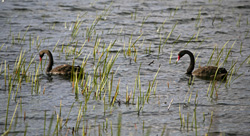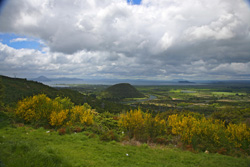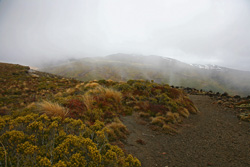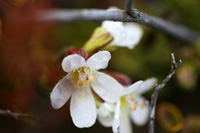





New Zealand: A Caravan Experience
Written By: SUSANNE LOMATCH
PAGE 4....
Rotorua, Taupo, Tongariro
Day 7-8
Tauranga and surrounds (‘Bay of Plenty’) are probably worth a day or two in warmer
summer weather. The area has the reputation of a Honolulu atmosphere, with its version
of Diamondhead and the surf, but much smaller and with seasons. Knowing that we
couldn’t enjoy many of the water activities, we drove inland toward Rotorua, popular for
its lakes and geothermal hotspots. Along the way on R36 we marveled at the many miles
of kiwi farms, one of NZ’s largest agricultural crops. Kiwi is a trellised crop similar to
wine grapes; each trellis bears a high density of fruit. Tall English-style hedges separate
matrices of trellises, and the farms seem to roll on forever in spots. NZ has two widely
available varieties of kiwis – golden and green. The green kiwi is firm and with fuzzy,
rough skin, and is widely exported to the U.S. The golden is softer and has smooth skin –
with tastes of tropical fruit – and is not widely available in the U.S. As beautiful as
Rotorua is – with forested areas and large lakes – we craved the mountainous terrain of
Tongariro, and a possible chance to do some hiking and spring skiing.
So we swung around Lake Rotorua, and caught R5, the ‘Thermal Explorer Highway.’
Along it, you will find several large volcanic thermal springs. Most of them have been
commercialized into rather expensive tourist areas requiring an entrance fee. If you’ve
already been to Yellowstone or Hawaii, skip them. But certainly don’t miss the free
views of them from the highway or local roads. And do stop at all of the places selling
honey and honey products. NZ honey is plentiful and incredible. There are many
varieties, but my favorites are Taranaki and Manuka honey, and the meads and honey
wines made from them. These honeys are dark-colored, and produce a rich, deep gold-colored
mead. Honeycomb is also available, and can be eaten directly from the package,
or is delicious on crackers. Coming out of Tauranga, and traveling through Rotorua
toward Taupo, we loaded up on honey and kiwis. One of our favorite stops was a honey
shop/meadery near Taupo, "Honey Hive Taupo." Featured are free tastings of meads and
honey wines, and they sell other specials, such as kiwi wine. Recommendations: Cottage
NZ Medium Mead (blended Taranaki mead), First Night Manuka Honey Wine, and
Redwood Kiwi Wine, made from kiwis grown near Nelson, NZ.
 We continued along the eastern shore of Taupo on R1, and knowing that we couldn’t
make Tongariro by nightfall we decided to stop at a quiet caravan park on the Lake,
Motuoapa Motor Camp. This place was not in our paper guides, but on the GPS; owned
and run by a local game fisherman and his family. Taupo is knighted as the "Trout
Capital of the World" and this was interesting, considering we’re from Idaho, where we
think of our own trout fishing as world-class. In the off or bridge season, caravan parks
can be ghost towns, and this was no exception. The quietude and pick of spots had us
facing the lake, and a small bay teaming with black swans and other waterfowl. With our
large bay window, watching the swans and crafty ducks was soothing – and went well
with our dinner of NZ lamb and a 2007 Soljans Estate Gisborne Pinotage. Golden kiwis
and Taranaki honey for dessert. A peaceful sleep followed by a bacon-and-eggs
breakfast, gourmet French press coffee and a hot shower got us revved up for the day.
We continued along the eastern shore of Taupo on R1, and knowing that we couldn’t
make Tongariro by nightfall we decided to stop at a quiet caravan park on the Lake,
Motuoapa Motor Camp. This place was not in our paper guides, but on the GPS; owned
and run by a local game fisherman and his family. Taupo is knighted as the "Trout
Capital of the World" and this was interesting, considering we’re from Idaho, where we
think of our own trout fishing as world-class. In the off or bridge season, caravan parks
can be ghost towns, and this was no exception. The quietude and pick of spots had us
facing the lake, and a small bay teaming with black swans and other waterfowl. With our
large bay window, watching the swans and crafty ducks was soothing – and went well
with our dinner of NZ lamb and a 2007 Soljans Estate Gisborne Pinotage. Golden kiwis
and Taranaki honey for dessert. A peaceful sleep followed by a bacon-and-eggs
breakfast, gourmet French press coffee and a hot shower got us revved up for the day.
 The road toward Tongariro (R47) climbs almost a mile in elevation, circling up to give
one last perched look of Lake Taupo, and then a hump into a completely different world.
From the perch, the history of Taupo becomes evident: a massive ancient volcanic
caldera that filled with water. Much to our chagrin, clouds returned and the views of
Tongariro were obscured. Thinking we might hike the famous Alpine Crossing we
stopped at the visitor center, only to be politely told that the trail was a snowfield, and the
emerald alpine lakes still frozen – ‘come back in December.’ Undeterred, we decided to
hike one of the trails near the center, and then continued upward off-trail, ever-searching
for that possible view above the fog bank. Not to be, but we encountered some haunting
terrain and curious flora.
The road toward Tongariro (R47) climbs almost a mile in elevation, circling up to give
one last perched look of Lake Taupo, and then a hump into a completely different world.
From the perch, the history of Taupo becomes evident: a massive ancient volcanic
caldera that filled with water. Much to our chagrin, clouds returned and the views of
Tongariro were obscured. Thinking we might hike the famous Alpine Crossing we
stopped at the visitor center, only to be politely told that the trail was a snowfield, and the
emerald alpine lakes still frozen – ‘come back in December.’ Undeterred, we decided to
hike one of the trails near the center, and then continued upward off-trail, ever-searching
for that possible view above the fog bank. Not to be, but we encountered some haunting
terrain and curious flora.


The magic of the terrain was already permeating. Hiking the
Alpine Crossing is a goal for many serious hikers. In NZ, hikers and hiking are referred
to as trampers and tramping. A hiking trail is a track. The Alpine Crossing is
approximately 25km round trip (~15.5mi), so the trek can be done in one day if you’re
suitably conditioned, as the trail is steep in spots. The terrain is similar to Haleakala
Crater on Maui as a comparison, except at Tongariro one is graced with the beautiful
emerald and blue lakes embedded in the colorful volcanic landscape, as well as dual
snow-capped volcanic peaks.